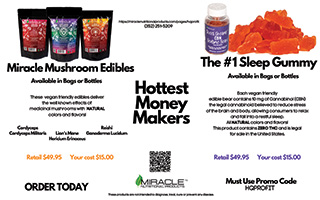The Data: Applying What We've Learned
Our industry is rapidly evolving. We’re experiencing the ripple effects of an over-digitized world, driven by a rejuvenated consumer base that pulsates to the rhythm of auto-tuned sexbots masquerading as pop stars. While we await the day artificial intelligence might render the Terminator saga prophetic, the venerable old-school shops, once interwoven on the fringes of society, find themselves sidelined by corporate America’s newcomers riding the crest of legalization. Our beloved local shops who for decades thrived on a culture made of human connections and personal interactions might be facing its biggest monster yet, as the war on cannabis is taking its last breath. But if our industry is known for something – besides being the dopiest – it is for its relentless resiliency.
This is where data analytics steps into the fray. Like David uses Goliath’s own sword to vanquish him, any local shop can harness the power of the digital leviathan for its own advantage, offering corporate titans a taste of their own medicine. However, the OGs in our industry possess something that eludes any corporate playbook, a secret ingredient that no merger, acquisition, or diversification can replicate. It is the rooted appreciation for an enduring culture, one that’s founded on the quintessential traits that make us human.
Need to catch up? Read Vol. 2 here.
In a crowded marketplace, companies need to distinguish themselves from their competitors. An effective and efficient way to do this is to find your target audience in their preferred online spaces and provide useful and informative content that attracts them to your online or physical storefront. In marketing circles, this is what is known as ‘inbound methodology
-Dr. Gabrielle Pogge
The Datanamics
“You Can’t Manage What You Can’t Measure.” You hear it constantly, likely most often from the young, digitally savvy members of your team. They get it. In truth, though, this wisdom traces back to Peter Drucker, a distinguished figure from the now-gone age group we revere as the “Greatest Generation.” Gen Z, you might be wondering if I’m veering off topic but rest assured, I’m not. The essence here is simple: If a man armed only with a typewriter and a penchant for calculators was aware of the power of data, shouldn’t you be as well?
In today’s marketplace, the journey to understanding, reaching, and engaging your target audience invariably circles back to data. This invaluable asset offers a roadmap to tailor your strategies with precision.
Building your Data Pool: Attracting and Engaging Potential Customers
In our fiercely competitive and saturated market, the battle for our customers’ attention is never-ending. After all, our average customer may face 99 problems, but finding a store that offers the necessary supplies isn’t one. How do we attract and retain new customers in the digital age? Luckily, we’ve once again brought in Dr. Gaby Pogge, our data scientist friend with a PhD in Social Psychology, to help us put a plan together.
The straightforward, though challenging, answer is to refine and expand your web and digital marketing strategies. “With a crowded marketplace, companies need to distinguish themselves from their competitors,” Dr. Pogge explains. “An effective and efficient way to do this is to find your target audience in their preferred online spaces and provide useful and informative content that attracts them to your online or physical storefront. In marketing circles, this is what is known as ‘inbound methodology.’” Let’s break that down into edible, tasty terpene-filled pieces.
Begin with your social media presence by ensuring you’re active on the appropriate platforms. Younger demographics, particularly Gen Z, prefer TikTok, Instagram, Snapchat, and YouTube, often viewing Facebook as a “cheugy” platform favored by millennials and boomers. But before you all-out abandon Zuck and his content-moderating minions, continue reading.
Facebook is a goldmine for industry-specific communities, offering a treasure trove of opportunities to uncover new store openings, spot emerging competitors, or dive into cannabis-themed groups to connect with your ideal customers. The aim is to transform these prospects into loyal patrons through targeted interactions. However, to truly resonate with younger audiences, it’s imperative to master their digital vernacular, serving up content that speaks directly to their interests and comfort zones. These groups act as your compass, pointing you to the heart of the action. Social media is without question the most affordable platform for engaging directly with your audience, leading them seamlessly to your online and physical storefronts. Forget about shelling out for paid ads; by crafting compelling content yourself, you can naturally draw customers to you.
Measuring Website Performance
Inbound methods allow you to attract potential customers to you without a dollar of ad spend. But how can you know if your inbound strategy is working for you?
“To effectively leverage inbound marketing, you need to know how visitors arrive to your site and the content they engage with when they get there,” Dr. Pogge explains. “Understanding traffic sources to your website and what users do when they arrive empowers you to make SEO and content decisions that will attract and engage your target audience, and ultimately, drive sales and revenue.”
Owning a website is good and owning a website that boosts your sales is fantastic. But you need to know how different aspects of your website are performing to make the most informed decisions. So, how can we measure website performance? Enter Google Analytics. And yes, for those wondering, Google Analytics does have a free version brimming with features perfect for individual sites and businesses on the smaller side.
Think of Google Analytics as your key to upgrading from the classic Ford Model A to the sleek Tesla Model S. Google Analytics collects demographic information based on the browsing data and activity associated with Google accounts. It’s a dashboard that not only tracks how visitors land on your site, be it through Google, Facebook, or referrals but also reveals their behaviors—like their favorite pages on your site—and their demographics, including age and gender. This information is a gold mine to understand the composition of your audience and tailor your content and marketing strategies accordingly.
While the sheer number of features on Google Analytics might seem daunting, the core functions—understanding your audience, analyzing traffic sources, monitoring user interactions, evaluating content, and tracking conversions—are surprisingly user-friendly. These essentials can significantly impact your business, even if you’re not the most tech-savvy entrepreneur. Pair this analytical power with a smart, well-executed social media campaign, and you’re set to become the brightest star in today’s crowded digital sky, drawing customers right to your doorstep. Here, you can work your traditional magic and convert visitors into loyal patrons.
Going Full Circle
Beyond customer acquisition, the true value lies in building customer loyalty. Acquiring a customer is only half the battle; the real challenge lies in retaining them. Once a customer is in your store, you have the opportunity to gather valuable information and customize your products and services to meet their needs.
One powerful way to gather data is by strategically leveraging your POS system. By encouraging customers to sign up for loyalty programs and provide basic information such as their name, email, contact number or social media accounts during transactions, you can capture valuable data. Tracking individual customer purchases allows you to gain insights into their preferences, frequency of visits, and spending habits and to tie it back together with your digital marketing strategy.
Armed with this information, you can tailor your promotions to reach specific customer segments, identify best-selling products and determine peak buying times. By implementing personalized marketing campaigns and utilizing targeted advertising on social media platforms, you can effectively re-engage existing customers and become a fierce competitor—even in a world of giants.
By Sofia Noillif












